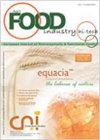Ultrasonic Dispersion Influence on the Rheological Properties of Double Emulsion Food Systems with a High Content of Polyunsaturated Fatty Acids
Q Engineering
引用次数: 0
Abstract
The author rheological parameters research of dual food emulsion systems with different oil base composition obtained by ultrasonic dispersion aims at determining the use prospects and studying the structural features. A man obtained flow curves for the double food emulsion systems under research by the rotational rheometry at temperatures of 20 °C and 30 °C. The emulsion systems demonstrated a non-Newtonian behavior, manifested as a change in viscosity with a shear flow velocity change. A comparative viscosity analysis of emulsion systems samples subjected to the ultrasonic dispersion for 10, 15 and 20 minutes showed that the dispersion duration did not have the significant effect on their rheological parameters. The flow curve of a sample with linseed and sunflower oils as a basis differs from the flow curves of samples with ginger–sunflower and mustard–sunflower oils combinations, which are characterized by a transition to the Newtonian flow regime at higher shear velocities. At the same time, the double emulsion systems viscosity does not depend on the blend composition. The temperature has no significant influence on the rheological parameters of most of the studied emulsion systems. The viscosity index was higher in a sample with linseed and sunflower oils as a base at a temperature of 20 °C at the same low values of shear velocities than at a temperature of 30 °C. The decrease in the dispersed structure strength along with an increase in temperature explains that.超声分散对高含量多不饱和脂肪酸双乳食品体系流变性能的影响
本文对超声分散法制备的不同油基组成的双食品乳化体系进行流变参数研究,旨在确定其使用前景,研究其结构特点。用旋转流变法得到了所研究的双食品乳化液体系在20℃和30℃下的流动曲线。乳液体系表现出非牛顿行为,表现为粘度随剪切流速变化而变化。经超声分散10、15和20分钟后,乳液体系样品的粘度对比分析表明,分散时间对其流变参数没有显著影响。以亚麻籽油和葵花籽油为基料的样品的流动曲线与以姜-葵花籽油和芥末-葵花籽油为基料的样品的流动曲线不同,后者的特征是在更高的剪切速度下过渡到牛顿流态。同时,双乳液体系的粘度不依赖于共混物的组成。温度对大多数乳状液体系的流变参数没有显著影响。以亚麻籽油和葵花籽油为基料的样品,在温度为20℃,剪切速度相同的低值下,粘度指数高于温度为30℃时的粘度指数。分散结构强度随温度升高而降低可以解释这一现象。
本文章由计算机程序翻译,如有差异,请以英文原文为准。
求助全文
约1分钟内获得全文
求助全文

 求助内容:
求助内容: 应助结果提醒方式:
应助结果提醒方式:


